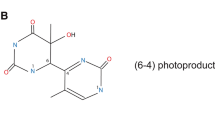Abstract
We identified a group of melanocytic lesions with an architectural pattern very similar to that of a junctional nevus: cells mostly grouped in distinct nests, more or less of the same size and shape, and regularly distributed along the dermoepidermal junction. In contrast with these nevus-like features, these neoplasms display additional details which are incompatible with a diagnosis of junctional nevus. These include areas of lentiginous array with focal pagetoid spread of melanocytes above the junction; marked cytological atypia, such as nuclear enlargement, hyperchromasia, nuclear membrane thickening and with a mild degree of cellular pleomorphism. Moreover, these lesions mostly developed on severely sun-damaged skin of old patients. Using a four-probe fluorescence in situ hybridization (FISH) assay targeting RREB1, MYB, Cep6, and CCND1, we found that seven of the eight propositus cases showed chromosomal aberrations consistent with the standardized FISH diagnostic criteria for melanoma. Instead, the five junctional nevi that served as controls were negative in this test. These findings underline the utility of correlating clinical–pathological observations with FISH analysis for diagnosing correctly as melanoma these malignant neoplasms, which closely simulate a junctional nevus.



Similar content being viewed by others
References
Zembowicz A, McCusker M, Chiarelli C et al (2001) Morphological analysis of nevoid melanoma, a study of 20 cases with a review of the literature. Am J Dermatopathol 23:167–175
Schmoeckel C, Castro CE, Braun-Falco O (1985) Nevoid malignant melanoma. Arch Dermatol Res 277:362–369
McNutt NS, Urmacher C, Halamian J et al (1985) Naevoid malignant melanoma: morphologic patterns and immunohistochemical reactivity. J Cutan Pathol 22:502–517
Blessing K, Evans AT, Al-Nafuss A (1983) Verrucous naevoid and keratotic melanoma: a clinicopathological study of 20 cases. Histopathology 23:455–458
Kossard S, Wilkinson B (1997) Small cell (naevoid) melanoma. A clinicopathologic study of 131 cases. Australas J Dermatol 38(Suppl):S54–S58
Kossard S, Wilkinson B (1995) Nucleolar organiser regions and image analysis nuclear morphometry of small cell naevoid melanoma. J Cutan Pathol 23:132–136
Blessing K, Grant JJH, Sanders DSA et al (2000) Small cell malignant melanoma, a variant of naevoid melanoma: clinicopathological features and histological differential diagnosis. J Clin Pathol 53:591–595
King R, Page RN, Googe PB et al (2005) Lentiginous melanoma: a histologic pattern of melanoma to be distinguished from lentiginous nevus. Mod Pathol 18:1397–1401
Kossard S (2002) Atypical lentiginous junctional naevi of the elderly and melanoma. Australas J Dermatol 43:93–101
Kossard S, Commens C, Symons M et al (1991) Lentinginous dysplastic naevi in the elderly: a potential precursor for malignant melanoma. Australas J Dermatol 32:27–37
Newman MD, Mirzabeigi M, Gerami P (2009) Chromosomal copy number changes supporting the classification of lentiginous junctional melanoma of the elderly as a subtype of melanoma. Mod Pathol 22:1258–1262
Gerami P, Mafee M, Lurtsbarapa T et al (2010) Sensitivity of fluorescence in situ hybridization for melanoma diagnosis using RREB1, MYB, Cep6, and 11q13 probes in melanomas. Arch Dermatol 146(3):273–278
Gaiser T, Kutzner H, Palmedo G et al (2010) Classifying ambiguous melanocytic lesions with FISH and correlation with clinical long-term follow-up. Mod Pathol 23:413–419
Gerami P, Zembowicz A (2011) Update on fluorescence in situ hybridization in melanoma. State of the Art. Arch Pathol Lab Med 135:830–837
Kim JC, Murphy GF (2000) Dysplastic melanocytic nevi and prognostically indeterminate nevomelanomatoid proliferations. Clin Lab Med 20:691–712
Sagebiel RW (1985) Histopathology of precursor melanocytic lesions. Am J Surg Pathol 9(Suppl):41–52
Skender-Kalnenas TM, English DR, Heenan PJ (1995) Benign melanocytic lesions: risk markers or precursors of cutaneous melanoma? J Am Acad Dermatol 33:1000–1007
Gerami P, Beilfuss B, Haghighat Z et al (2011) Fluorescence in situ hybridization as an ancillary method for the distinction of desmoplastic melanomas from sclerosing melanocytic nevi. J Cutan Pathol 38:329–334
Gammon B, Beilfuss B, Guitart J et al (2011) Fluorescence in situ hybridization for distinguishing cellular blue nevi from blue nevus-like melanoma. J Cutan Pathol 38:335–341
Pouryazdanparast P, Haghighat Z, Beilfuss BA et al (2011) Melanocytic nevi with an atypical epithelioid cell component: clinical, histopathologic, and fluorescence in situ hybridization findings. Am J Surg Pathol 35:1405–1412
Conflict of interest
None.
Author information
Authors and Affiliations
Corresponding author
Additional information
I. Pennacchia and S.Garcovich equally contributed to this work.
Rights and permissions
About this article
Cite this article
Pennacchia, I., Garcovich, S., Gasbarra, R. et al. Morphological and molecular characteristics of nested melanoma of the elderly (evolved lentiginous melanoma). Virchows Arch 461, 433–439 (2012). https://doi.org/10.1007/s00428-012-1293-0
Received:
Revised:
Accepted:
Published:
Issue Date:
DOI: https://doi.org/10.1007/s00428-012-1293-0




